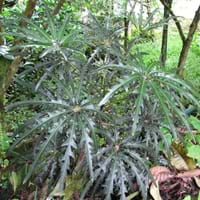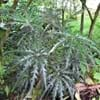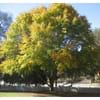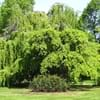Life Span
Perennial
Perennial
Origin
Polynesia
Northeastern United States, Mid-Atlantic United States, Central United States, Canada
Types
Not Available
Blue ash, Single-leaf ash, Fragrant ash
Habitat
Forest edges, gardens, Homesteads
Moist Soils
USDA Hardiness Zone
10-15
3-7
Sunset Zone
H1, H2, 16, 17, 22, 23, 24
Not Available
Habit
Upright/Erect
Upright/Erect
Flower Color
Yellow, Red, Green
Green, Purple
Flower Color Modifier
Bicolor
Bicolor
Fruit Color
Blue, Black
Green, Tan
Leaf Color in Spring
Red, Green, Dark Green, Brown
Green, Dark Green
Leaf Color in Summer
Red, Green, Dark Green, Brown
Dark Green
Leaf Color in Fall
Red, Green, Dark Green, Brown
Yellow, Yellow green, Brown, Bronze
Leaf Color in Winter
Red, Green, Dark Green, Brown
Not Available
Leaf Shape
Compound
Pinnate
Plant Season
Spring, Summer, Fall, Winter
Spring, Summer
Sunlight
Full Sun, Partial Sun, Partial shade
Full Sun
Type of Soil
Loam, Sand
Clay, Loam, Sand
The pH of Soil
Neutral, Alkaline
Acidic, Neutral
Soil Drainage
Well drained
Average
Bloom Time
Indeterminate
Early Spring, Spring
Tolerances
Not Available
Wet Site
Where to Plant?
Ground
Ground
How to Plant?
Seedlings
Seedlings
Plant Maintenance
Medium
Medium
Watering Requirements
Do Not over Water, Keep ground moist
Average Water Needs
In Summer
Lots of watering
Lots of watering
In Spring
Moderate
Moderate
In Winter
Average Water
Average Water
Soil pH
Neutral, Alkaline
Acidic, Neutral
Soil Type
Loam, Sand
Clay, Loam, Sand
Soil Drainage Capacity
Well drained
Average
Sun Exposure
Full Sun, Partial Sun, Partial shade
Full Sun
Pruning
Prune if you want to improve plant shape, Remove damaged leaves, Remove dead branches, Remove dead leaves
Prune in fall, Prune in winter, Prune when plant is dormant, Remove branches, Remove damaged leaves, Remove dead branches, Remove dead leaves, Remove dead or diseased plant parts, Remove short twigs
Fertilizers
All-Purpose Liquid Fertilizer
All-Purpose Liquid Fertilizer
Pests and Diseases
Mites, Nematodes, Scale
Red blotch
Plant Tolerance
Drought
Wet Site
Flowers
Insignificant
Insignificant
Flower Petal Number
Single
Not Available
Foliage Texture
Medium
Medium
Foliage Sheen
Glossy
Glossy
Attracts
Not Available
Birds
Allergy
no allergic reactions
Not Available
Aesthetic Uses
Showy Purposes
Showy Purposes
Beauty Benefits
Not Available
Not Available
Edible Uses
No
Insignificant
Environmental Uses
Air purification
Air purification, Nesting sites for birds, Wildlife, Windbreak
Medicinal Uses
Not Available
Antirheumatic, Diaphoretic, Diuretic, Fever, Gout, Laxative, Ophthalmic, Purgative, Sore Eyes, Sore throat, Tonic
Part of Plant Used
Whole plant
Inner Bark, Leaves, Tree trunks
Other Uses
Used as Ornamental plant
Basketary, Used as a dye, Used as fuel, Used for woodware
Used As Indoor Plant
Yes
No
Used As Outdoor Plant
Yes
Yes
Garden Design
Container, Feature Plant, Hedges, Houseplant, Screening / Wind Break, Topiary / Bonsai / Espalier, Tropical
Shade Trees, Water Gardens
Botanical Name
Plerandra elegantissima
FRAXINUS nigra
Common Name
False Aralia
Black Ash, Brown Ash, Swamp Ash
In Hindi
Aralia
Black Ash plant
In German
falsch Aralia
Black Ash Pflanze
In French
faux Aralia
plante Black Ash
In Spanish
Falso Aralia
planta de negro de Ceniza
In Greek
Λάθος Aralia
φυτό μαύρη τέφρα
In Portuguese
Aralia false
planta Black Ash
In Polish
fałsz Aralia
Black Ash roślin
In Latin
falsum Aralia
Black ash herba
Phylum
Not Available
Magnoliophyta
Class
Magnoliopsida
Magnoliopsida
Order
Apiales
Scrophulariales
Family
Araliaceae
Oleaceae
Clade
Angiosperms, Asterids, Eudicots
Angiosperms, Asterids, Eudicots
Tribe
Not Available
Oleeae
Subfamily
Not Available
Not Available
Number of Species
Not Available
Not Available
Importance of False Aralia and Black Ash
Want to have the most appropriate plant for your garden? You might want to know the importance of False Aralia and Black Ash. Basically, these two plants vary in many aspects. Compare False Aralia and Black Ash as they differ in many characteristics such as their life, care, benefits, facts, etc. Every gardener must at least have the slightest clue about the plants he wants to plant in his garden. Compare their benefits, which differ in many ways like facts and uses. The medicinal use of False Aralia is Not Available whereas of Black Ash is Antirheumatic, Diaphoretic, Diuretic, Fever, Gout, Laxative, Ophthalmic, Purgative, Sore Eyes, Sore throat and Tonic. False Aralia has beauty benefits as follows: Not Available while Black Ash has beauty benefits as follows: Not Available.
Compare Facts of False Aralia vs Black Ash
How to choose the best garden plant for your garden depending upon its facts? Here garden plant comparison will help you to solve this query. Compare the facts of False Aralia vs Black Ash and know which one to choose. As garden plants have benefits and other uses, allergy is also a major drawback of plants for some people. Allergic reactions of False Aralia are no allergic reactions whereas of Black Ash have Not Available respectively. Having a fruit bearing plant in your garden can be a plus point of your garden. False Aralia has no showy fruits and Black Ash has no showy fruits. Also False Aralia is not flowering and Black Ash is not flowering . You can compare False Aralia and Black Ash facts and facts of other plants too.





